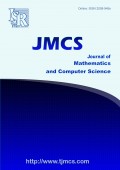

Darrell Cox - Grayson County College , Denison, TX 75020, USA. Sourangshu Ghosh - Indian institute of Technology Kharagpur, Kharagpur, West Bengal 721302, India. Eldar Sultanow - Potsdam University, 14482 Potsdam, Germany. - Capgemini, 90402 Nuremberg, Germany.
The next element in the $3n+1$ sequence is defined to be \((3n+1)/2\) if \(n\) is odd or \(n/2\) otherwise. The Collatz conjecture states that no matter what initial value of \(n\) is chosen, the sequence always reaches 1 (where it goes into the repeating sequence \((1,2,1,2,1,2,\ldots)\)). The only known Collatz cycle is \((1,2)\). Let \(c\) be an odd integer not divisible by \(3\). Similar cycles exist for the more general \(3n+c\) sequence. The \(3n+c\) cycles are commonly grouped according to their length and number of odd elements. The smallest odd element in one of these cycles is greater than the smallest odd elements of the other cycles in the group. A parity vector corresponding to a cycle consists of 0's for the even elements and 1's for the odd elements. A parity vector generated by the ceiling function is used to determine this smallest odd element. Similarly, the largest odd element in one of these cycles is less than the largest odd elements of the other cycles in the group. A parity vector generated by the floor function is used to determine this largest odd element. This smallest odd element and largest odd element appear to be in the same cycle. This means that the parity vector generated by the floor function can be rotated to match the parity vector generated by the ceiling function. Two linear congruences are involved in this rotation. The natural numbers generated by one of these congruences appear to be uniformly distributed (after sorting).
Darrell Cox, Sourangshu Ghosh, Eldar Sultanow, Generalizing Halbeisen's and Hungerbühler's optimal bounds for the length of Collatz cycles to \(\boldsymbol{3n+c}\) cycles, Journal of Mathematics and Computer Science, 24 (2022), no. 4, 330--337
Cox Darrell, Ghosh Sourangshu, Sultanow Eldar, Generalizing Halbeisen's and Hungerbühler's optimal bounds for the length of Collatz cycles to \(\boldsymbol{3n+c}\) cycles. J Math Comput SCI-JM. (2022); 24(4):330--337
Cox, Darrell, Ghosh, Sourangshu, Sultanow, Eldar. "Generalizing Halbeisen's and Hungerbühler's optimal bounds for the length of Collatz cycles to \(\boldsymbol{3n+c}\) cycles." Journal of Mathematics and Computer Science, 24, no. 4 (2022): 330--337